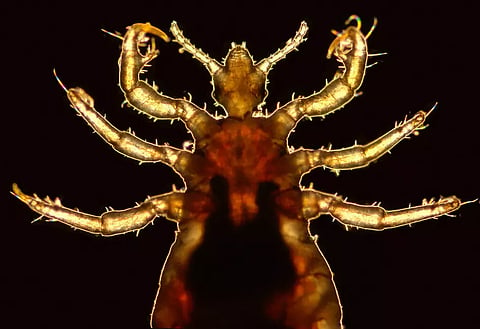

NEW YORK: Along our evolutionary journey from monkey-like primates to bipedal apes to big-brained humans, we have had the company of an extraordinarily loyal companion: Pediculus humanus, otherwise known as the human louse. And all the while, the lice have recorded this journey in their genes. A new study, for example, found that some lice in the Americas are hybrids of those carried there by Native Americans and others ferried across the Atlantic by European colonists.
“We humans do not live in a bubble,” said Marina Ascunce, an evolutionary geneticist at the U.S. Department of Agriculture and an author of the new study. “Lice are part of our lives and our history.”
Lice commonly dwell on people’s heads, clamping onto hair shafts, piercing scalps and drinking blood. Unable to survive away from human bodies, the parasites jump from one person to the next. If people are crammed together in unsanitary conditions — such as an overcrowded jail — lice can spread into clothes and feed on other body parts.
Other mammals and birds have lice of their own. Each species of the parasite has exquisite adaptations to its particular host, be it a penguin or a bat. This intimate association is ancient. In Germany, paleontologists discovered a 44-million-year-old louse with bits of feathers preserved in its gut.
Lice fossils are too rare to reveal very much about their history. But their DNA contains many additional clues. By analysing genetic material from lice, entomologists can build their family trees, revealing which species are most closely related.
Often, the closest relative of a louse species lives on the closest relative of its host. For example, in the early 2000s, David Reed of the University of Florida and his colleagues found that human lice are most closely related to lice that live on chimpanzees and more distantly related to lice that live on monkeys. For some 25 million years, in other words, our lice have been following us down our evolutionary path.
That’s not to say that lice are completely loyal. Another species, Pthirus pubis (better known as crabs), dwells only in human pubic hair. Crabs are not closely related to head lice. Instead, Dr. Reed and his colleagues have found, their closest cousins are lice that live on gorillas. It’s possible that early human ancestors picked crabs up while sleeping in an old gorilla nest, or feeding on gorilla carcasses. In another provocative study, Dr. Reed and his colleagues compared human lice from different parts of the world. They looked at genetic material known as mitochondrial DNA, which is passed down only from females to their offspring. The researchers found that many lice belonged to one of two lineages. Remarkably, those lineages split from a female louse that lived perhaps a million years ago.
Dr. Reed and his colleagues speculated that this deep split came about when humans expanded out of Africa. Along with their own lice, they picked up lice from Neanderthals or some other extinct group of humans. More recently, lice researchers have turned their attention to the chromosomal DNA that lice inherit from both their mothers and fathers. In 2010, Dr. Ascunce joined Dr. Reed’s team and led an effort to collect such DNA from a broader sweep of the world.